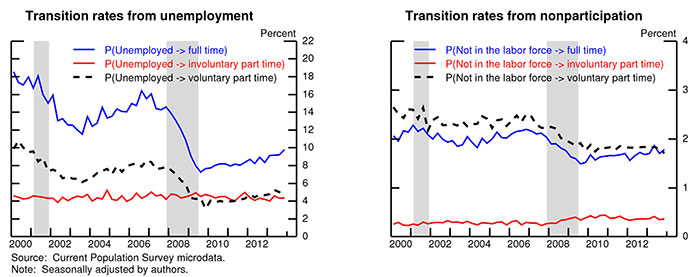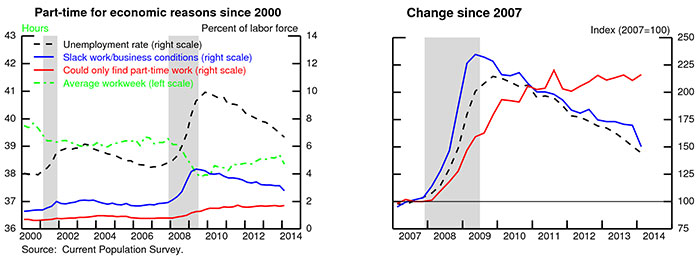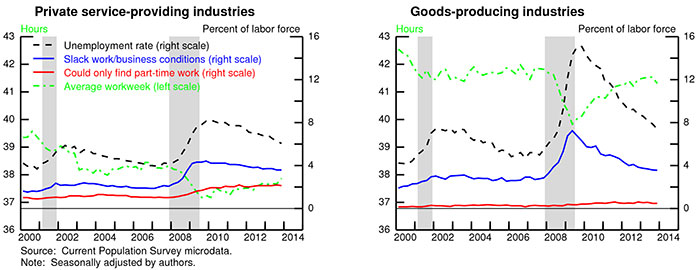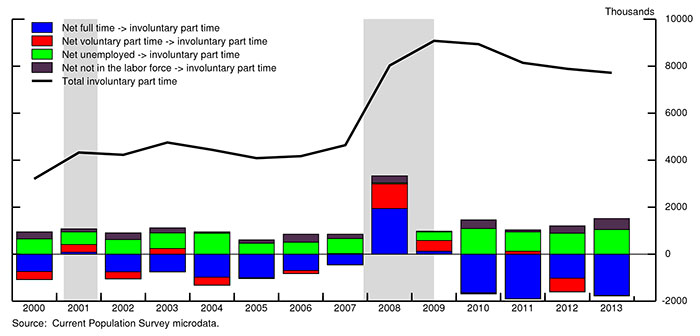FEDS Notes
April 14, 2014
Why is Involuntary Part-Time Work Elevated?
Tomaz Cajner, Dennis Mawhirter, Christopher Nekarda, David Ratner
Despite substantial improvement in the unemployment rate and several other labor market indicators, the number of Americans involuntarily working part time (also called "part-time for economic reasons") remains unusually high nearly five years into the recovery.1 The high level of involuntary part-time work has led to a concern that there is an underbelly of labor market slack not well accounted for by the overall unemployment rate. In this note, we focus on two questions:
- What can Current Population Survey (CPS) data on the stocks and flows of involuntary part-time employment say about the underlying reasons for its persistently high rate?
- Based on this analysis, what can we expect for the evolution of involuntary part-time work going forward?
Our analysis suggests there are reasons to believe that continued cyclical improvement in the labor market will put downward pressure on involuntary part-time work, but there is also a possibility that secular trends may augur structurally higher part-time employment.
The persistently high stock of involuntary part-time work
Chart 1 presents the two main categories of involuntary part-time work: i) individuals who work part time due to slack work or unfavorable business conditions, and ii) individuals who could only find part-time work, each as a percentage of the labor force (left panel) and for each its change since 2007 (right panel). For comparison purposes, we also plot the unemployment rate and average weekly hours by persons at work (the workweek). The decomposition in Chart 1 yields our first observation: although the share of individuals in the labor force working part time due to slack work or business conditions has declined roughly along with the unemployment rate, the percentage of individuals reporting they could only find part-time work has continued to increase.
Digging a little bit further, we find that there are stark differences across two major industry groups in the behavior of involuntary part-time work.2 Chart 2 plots the same four measures from Chart 1, but calculated separately for private service-providing industries (the left panel) and goods-producing industries (the right panel). In the goods-producing sector, involuntary part-time employment due to slack conditions has subsided along with unemployment, and remains only one third higher than its pre-recession level. In services, however, the progress has been somewhat slower and the fraction working part-time due to slack conditions remains substantially elevated. Additionally, involuntary part-time work due to inability to find full-time work remains almost double its pre-recession level in both sectors, although it represents a bigger share in services. The higher prevalence of the latter type of involuntary part-time work in service-providing industries could be related to some intrinsic (technological) characteristics of these industries. For example, the leisure and hospitality and the retail trade industries both have shorter workweeks and a higher share of part-time workers, likely reflecting some organizational aspects of their production processes. Ongoing transformation of U.S. employment away from manufacturing and towards services-providing industries could lead to a secularly-increasing share of (involuntary) part-time work going forward, although quantitatively the effect is expected to be modest.3
Flows into and out of involuntary part-time work
While involuntary part-time employment could be a result of downgrading workweeks, it might also serve as a stepping-stone to full-time work for the unemployed or persons joining the labor force. Our analysis of labor market transitions from the CPS indicates that full-time work is not eroding, but rather that workers are beginning to upgrade to full-time work again.
In Chart 3, we plot the net annual flow of workers among different labor market states from 2000 onwards, together with the overall stock of involuntary part-time workers.4 For example, the blue bars show the number of workers (in thousands) that move from full-time employment to involuntary part-time employment minus the number of workers moving from involuntary part-time employment to full-time employment. As the recession took hold, workers moved from full-time employment to part-time work for economic reasons, accounting for more than half of the increase in involuntary part-time work. Indeed, these developments are consistent with the decline in workweeks during the recession. Since 2010, however, the tide turned against a shortening of average workweeks and workers have transitioned, on net, from involuntary part-time employment to full-time employment (represented by the negative blue bars), at the pace of roughly 125,000 workers per month.
Another interesting finding from the data on labor market transitions is that about one third of the increase in part-time employment for economic reasons during the recession represented a shift from voluntary part-time to involuntary part-time employment (the red bars). It is conceivable that this merely represents a measurement issue: for example, in times with a weak labor market, CPS respondents became more likely to attribute their part-time hours to economic reasons than to noneconomic reasons (for example, family obligations or other personal reasons). On the other hand, it could be that the increased flow from voluntary to involuntary part-time work during the recession represented a real behavioral change: for example, if a household's primary earner experienced a spell of unemployment, the secondary earner, who had previously been working part-time for noneconomic reasons, might have wished to work longer hours, and thus reported working part-time for economic reasons.
The net flow from unemployment to involuntary part-time work has grown since 2010 (green bars), thus increasing the stock of the latter. This is, however, a natural consequence of an improving labor market in which more unemployed workers are able to find jobs, and the same pattern is observable in the years prior to the Great Recession. Indeed, our data generally paint a picture of a labor market recovering from an exceptionally large shock, in a normal, albeit gradual, fashion.
This view is supported by looking more closely at the transition rates out of unemployment and out of nonparticipation. In particular, Chart 4 plots the monthly probability that a person who was unemployed (left panel) or a nonparticipant (right panel) the previous month was employed full-time, employed part-time for economic reasons, or employed part-time for noneconomic reasons the next month. Some observers have expressed concerns that most jobs created during the recovery have been part-time, and thus lower quality. The data, however, indicate that involuntary part-time jobs represent less than one quarter and less than one tenth of all transitions into employment from unemployment and nonparticipation, respectively. Chart 4 also reveals an interesting (and, to the best of our knowledge, hitherto unnoticed) observation: the transition rates from unemployment/nonparticipation to involuntary part-time work exhibit essentially no cyclicality, which is in stark contrast with the highly procyclical transition rates into full-time and voluntary part-time employment. This acyclicality is likely due to an offsetting decline in all employment opportunities at the same time as a shift towards more part-time work during cyclical downturns. As the recovery continues, we should expect to see further increases in the transition probabilities from unemployment to full-time and voluntary part-time jobs, which should in turn put downward pressure on the stock of part-time workers.
| Chart 4: Transition rates from unemployment or nonparticipation to full-time or part-time employment |
|---|
 |
Prospects for improvement in involuntary part-time employment
Our analysis offers several clues on why involuntary part-time work has increased during the recession and why it has remained elevated even as other labor market measures have improved. Cyclical forces likely accounted for the bulk of its increase during the recession, but as the economy has improved, the number of persons working part-time due to slack business conditions has recovered. On the other hand, the share of workers who could only find part-time work remains high, and the continuing lack of available jobs weighs on the ability of unemployed and involuntary part-time workers to find full-time jobs. As hiring improves, this should further reduce the share of involuntary part-time work.
Our examination of the data also suggests that secular changes in the industrial composition of employment could lead to a permanently elevated share of involuntary part-time work. That said, when interpreting involuntary part-time work as an additional measure of underemployment, one should note that the average workweek of involuntary part-time workers is roughly half of the average workweek of full-time workers, hence this measure should be appropriately weighted when compared to other standard measures of underemployment (e.g., unemployed and marginally attached workers). All told, although the number of persons working part-time involuntarily remains unusually high, our analysis suggests that this primarily reflects continued weak labor market conditions and that the share part-time employment will likely diminish as the labor market improves.
1. We use the terms "working part-time for economic reasons" and "involuntary part-time employment" interchangeably. The Bureau of Labor Statistics (BLS) defines persons working part-time for economic reasons as a subset of those working part time (that is, 1 to 34 hours). The subset is defined as those reporting an economic reason such as slack work or unfavorable business conditions, inability to find full-time work, or seasonal declines in demand. Return to text
2. A detailed industry-level analysis is beyond the scope of this note. For an earlier work in this direction, see Bruce C. Fallick (1999), "Part-time work and industry growth," Monthly Labor Review, March 1999, pp. 22–29. An analysis of part-time work by demographic groups can be found in Rob Valletta and Leila Bengali (2013), "What's Behind the Increase in Part-Time Work," FRBSF Economic Letter, 2013-24. Return to text
3. Since 2000, the changing industry composition contributed a few tenths of a percentage point to the share of involuntary part-time work in the labor force. Return to text
4. We construct Chart 3 from monthly CPS data. In particular, we computed net flows between five labor market states: full-time employment, part-time for economic reasons, part-time for non-economic reasons, unemployment, and out of the labor force. It is well known that the flows calculated from the matched data do not cumulate to the stocks. We followed Elsby, Hobijn, and Sahin (2013) and statistically adjusted the flows so they are consistent with the stocks from the full CPS sample. For details, see Michael W.L. Elsby, Bart Hobijn, Aysegül Sahin (2013), "On the Importance of the Participation Margin for Labor Market Fluctuations," FRBSF Working Paper, 2013-05. Return to text
Please cite as:
Cajner, Tomaz, Dennis Mawhirter, Christopher J. Nekarda, and David Ratner (2014). "Why is Involuntary Part-Time Work Elevated?" FEDS Notes. Washington: Board of Governors of the Federal Reserve System, April 14, 2014. https://doi.org/10.17016/2380-7172.0014
Disclaimer: FEDS Notes are articles in which Board economists offer their own views and present analysis on a range of topics in economics and finance. These articles are shorter and less technically oriented than FEDS Working Papers.



